蒸汽基础
蒸汽加热机理
本文将先探讨蒸汽是如何均匀、快速加热的,继而,将讨论通过实验数据得出的热水与蒸汽换热的比较。
蒸汽如何提供稳定、均匀的加热?
不是通过传导换热(如热水),而是冷凝换热(如蒸汽),就不会发生温度变化;当蒸汽在换热器壁上冷凝时,释放潜热,把热量传递给被加热产品,形成的冷凝水仍含有显热,与同压力下的蒸汽温度一致,整个换热面都能均匀加热。
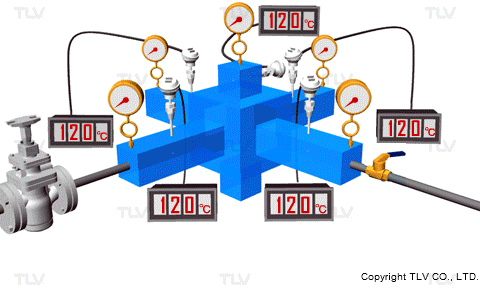
如果设备换热表面(如夹套,壳体或盘管)的压力恒定,则换热表面的每个部分都能得到连续恒温的加热。
另一方面,用热水或油加热,由于显热传递给了产品,换热介质的温度会降低。由于每单位质量介质换热后温度会降低,就会形成明显的温度梯度,这会导致加热不均匀,从而对加热的产品产生不利影响。
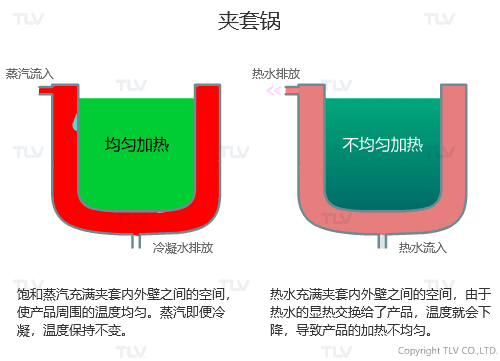
蒸汽如何进行快速的加热?
冷凝换热(蒸汽)
所有的秘密在于通过冷凝的过程进行换热。
蒸汽中的潜热在其冷凝成液态时快速被释放。冷凝后释放的潜热值大约是热水(饱和水)显热值的2~5倍。这种潜热瞬间释放,并通过换热面传递给产品。
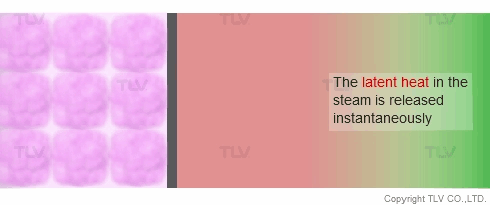
通过冷凝,蒸汽自然流经换热面,这有助于加快换热工艺。
通过对流换热(热水或油)
相反,热水和油通过对流来换热,不会发生相变。如果任其自然对流,换热是极其缓慢的。因此,通常会借用泵来增加流经换热面的流量,以提高换热率,这就是所谓的强制对流加热。
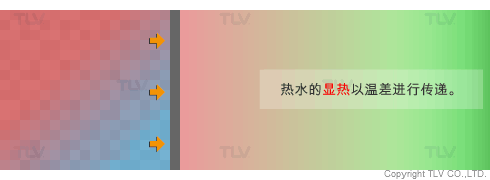
换热率
流体和固体之间换热率通常不是由对流换热系数直接得出,大致参考值为:
- 热水的换热系数大约为1000 — 6000 W/(m2°C) [176-1057 Btu/(hr-ft2°F)]
- 蒸汽的换热系数大约为6000 — 15000 W/(m2°C) [1057 - 2641 Btu/(hr-ft2°F)]
然而,在换热器中,由于换热是通过多种介质进行的,所以换热工艺不能仅仅只考虑对流换热系数。换热通常是以下三种换热机理的结合:
- 从换热介质换热到换热器的壁面
- 在换热器中的多层内壁之间的热传递
- 从换热器的壁面到产品的热传递
因此,换热器总的换热系数(即U值)是三种换热过程的总换热系数的结合,其单位相同,为W/(m2°C)或 Btu/(hr-ft2°F)。
实验数据
不同工况的换热器的U值差异很大,但从实验数据不难看出蒸汽加热的U值一般能达到热水加热的1.7倍左右。以下是A公司将夹套锅的换热介质由热水改为真空蒸汽的例子:
任务: 通过缩短浓缩稀释在化学试剂中的溶剂所需要的时间来提高产量。
分类:精细化工
设备: 玻璃内衬夹套锅 (10m3)
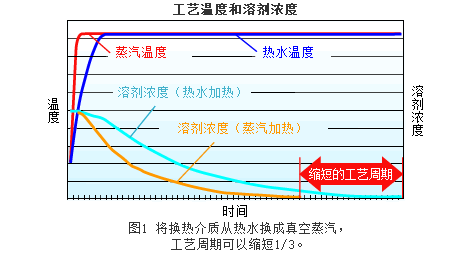
| 对流换热系数 | 总换热系数 | 工艺时间 | |
|---|---|---|---|
| 热水 | 500 W/m2°C | 213 W/m2°C | 10小时 |
| 真空蒸汽 | 10000 W/m2°C | 356 W/m2°C | 7小时 |
如数据所示,U值增加了1.7倍,显著缩短了生产周期。
有关总换热系数的更详细的计算和公式,请查阅本章节的下一篇内容。